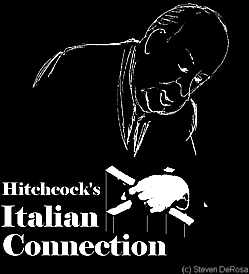Alfred Hitchcock's Italian Connection
Hitchcock's
near switch from cool blondes to the hot-blooded Sophia Loren with R.R.R.R.

Previously I have mentioned how the 1960s were difficult years for Alfred Hitchcock, indeed for most of Hollywood. The studio system had been in decline since the late 1940s with the advent of television and the increasing independence of talent no longer under contract to the majors. It seemed that with the exception of big-budget road-show musicals, Hollywood was in trouble. And yet, the avant-garde cinema, particularly filmmakers from Europe were suddenly dominating the scene. Hitchcock was nobody’s fool and as usual tried to adapt to the current trends. At the same time he was trying to get Mary Rose off the ground, and in the very early stages of kicking around the idea for his ultra-hip, but never-to-be-made Frenzy, the director looked to the land of Federico Fellini and Michelangelo Antonioni for inspiration.
Hitchcock enjoyed Big Deal on Madonna Street, which starred Vittorio Gassman and Marcello Mastroianni, and hoped to bring that same flavor to an Italian caper picture of his own by engaging the screenwriting team Agenore Incrocci and Furio Scarpelli, who worked as Age and Scarpelli.
“It was about a hotel like the Plaza,” explained Hitchcock. “The manager was Italian, his mother lived in the penthouse, and his relatives held different jobs in the hotel. They were all crooks, but he himself didn’t go in for this crookery so he was blackmailed by the rest of the family. When a woman like Sophia Loren arrives with a collection of coins she wanted to sell and took a room, of course all the family have itchy fingers. So he had to fight against his own family about stealing the coins.” The title was to be R.R.R.R., as Hitchcock explained, “Numismatists mark coins by the letter R. R, RR, RRR, RRRR.” No doubt, the title was to have a double-meaning, grading not only the coins to be stolen, but the leading lady as well.
“But the story didn’t turn out.” recalled the director. “It got too complicated. I had two Italian writers over and there was a language barrier. I’ve abandoned projects after spending $ 150,000 on them. I knew it wasn’t going to go anywhere, so I gave it up. I threw it away ... and the writer(s) with it.”
The Italian influence was strong on Hitchcock though, and so even while he was in the midst of beginning work on R.R.R.R., he sought the services of the prolific Italian screenwriter Cesare Zavattini. Among Zavattini’s many credits were The Bicycle Thief, Indiscretion of an American Wife, Two Women and Yesterday, Today and Tomorrow. He had worked with Fellini, Antonioni, and DeSica, and now Hitchcock was interested in learning what Zavattini’s fee would be to write a treatment and screenplay based on an original idea which eventually became Torn Curtain. In January 1965, Peggy Robertson, Hitchcock’s assistant, wrote to Guilio Ascarelli of Universal Pictures Rome, stating:
Now as regards Cesare Zavattini: Mr. Hitchcock has an idea for a motion picture story; it is a dramatic idea something along the lines of a picture he made in 1946 called "NOTORIOUS" (I do not know the Italian title of the picture, but it starred Ingrid Bergman, Cary Grant and Claude Rains). What would be the minimum fee Mr. Zavattini would take to develop Mr. Hitchcock's idea into a story outline? When Mr. Hitchcock has approved the story outline - what would be the fee for the screenplay? Does Mr. Zavattini have any commitment, or is he quite free to work on this project?
Peggy
Although Zavattini was in the middle of scripting Un Monde Nouveau (A New World) for Vittorio DeSica, Ascarelli reported that the writer was very eager to work with Hitchcock. By Hollywood standards, his fees were very reasonable, too. To develop Hitchcock’s idea into a story outline, Zavattini required eight million Italian lire, a little under $13,000 at the time, and for the screenplay, thirty million lire, about $48,000.
Ascarelli added, “As you know Zavattini has a great reputation in Italy, but from confidential information I have been able to obtain, it appears that his strength lies more in the story outline than in the actual screenplay.” He also reported that “Age and Scarpelli are back in Rome and came in to see me yesterday. They were highly delighted with their trip and the friendly and warm reception accorded to them by Mr. Hitchcock and your very self. They think you are as charming as I know you are ...They are going to work now on the story outline and I will naturally be in constant touch with them.” Before long though, and very likely due to pressure from ‘the front office’ at Universal, Hitchcock postponed and then abandoned plans to engage Zavattini. Robertson replied:
January 25, 1965
Dear Guilio,
Mr. Hitchcock has given very serious consideration to the matter of Mr. Zavattini and has come to the conclusion that he should postpone the thought of Mr. Zavattini writing a story outline from his idea ... This postponement is due to the fact that Mr. Hitchcock does not feel he should have two Italian writers (Age and Scarpelli being one) working on story outlines at such a great distance from here and at the same time. Please be assured that it is definitely not a question of money as Mr. Hitchcock would certainly be happy to pay eight million Italian Lire for a story outline of Mr. Z's. If Mr. Zavattini would care to submit a story outline to Mr. Hitchcock, he would be extremely happy to read it.
Best regards, As ever
Peggy
Unfortunately the collaboration with Cesare Zavattini did not happen and Torn Curtain never lived up to the promise of “something along the lines of Notorious.” As for R.R.R.R., it is a shame that Hitchcock didn’t pursue the idea further as it would have been an interesting change of pace.
Copyright 2001 Steven DeRosa


